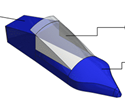Rancang Bangun Bodi Mobil Listrik Menggunakan Fiberglass
DOI:
https://doi.org/10.55679/pistonjt.v10i1.84Keywords:
Mobil Listrik, Body Mobil, Komposit, Fiberglass, Metode hand lay upAbstract
Electric cars are cars that are driven by electric motors and use electrical energy stored in batteries. The use of electric cars certainly requires a vehicle design that can meet automotive needs that are more focused on the chassis and body. The performance of electric cars is influenced by the weight and aerodynamics of the car itself, one of which is the body of the electric car, to produce good performance, a design that has a low drag coefficient value is needed so that it can cut through the wind well and make this electric car go fast. The material used to make this electric car body is fiberglass with a hand lay up application technique. In making it, several preparations are needed, namely making designs, making moulds, and making bodies using fiberglass media. The results of the study indicate that for the specifications of the car body design results, namely the body height of 60 cm, body width of 82 cm, body length of 2.73 m, upper body width of 63 cm, inner body width of 50 cm, front body height of 37 cm, body glass length of 101 cm, glass width of 63 cm, rear glass height of 44.5 cm, front glass height of 10.5 cm with a body weight of 19.25 kg and a glass weight of 2.15 kg. The conclusion of this study is that the prototype body of the electric car can be attached to the frame properly after the car is used or driven and the prototype body. Electric cars are made of fiberglass, this material is very appropriate because it has a light character, easy to shape. But for performance in electric cars, body weight greatly affects the speed of electric cars so it is hoped that further research will be developed with a lighter form of electric car body.
Downloads
References
M. Adriana, A. Angkasa dan Masrianor. “Rancang Bangun Rangka (casis) Mobil Listrik Roda Tiga Kapasitas Satu Orang,” Jurnal Elemen, vol. 4, no. 2, Desember 2017.
Endangkasia. Perancangan dan Pembuatan Chassis Mobil Listrik Kapasitas Angkut 4 Orang. https://textid.123dok.com/document/9ynlj0lqperancangan-dan-pembuatan-chassis-mobil-listrik-kapasitasangkut-4orang.html. Malang. 2012 (Diakses pada tanggal 15 Mei 2024).
Suriyadi, U. Ibuhasa, M. Abdillah, Rizki, L. O. A. Barata, and Samhuddin, “Perancangan Pembuatan Kapal Tenaga Surya Skala Miniatur”, Piston-JT, vol. 7, no. 2, pp. 1–6, Dec. 2022.
S. Alfissin, M. Z. Yuliadi dan D. Wahyudi. “Pengaruh Susunan Serat Laminasi Fiberglass terhadap Kekuatan Tarik dan Tekuk Material Menggunakan Variasi Chopped Standart Mat dan Woven Roving”, Jurnal Midship, vol. 2, no. 2, Oktober 2019.
A. S. Haryono. Pemanfaatan Fiberglass Untuk Pembuatan Body Plastik Kendaraan Ahmad Haryono , ST. Politeknosains, 2011.
P. H. Adiwibowo. “Rancang Bangun Bodi Mobil Listrik Garuda Unesa (Garnesa)”. JRM. vol. 01 no. 01, 2013.
Alamsyah, T. Hidayat dan A. N. Iskandar. “Pengaruh Perbandingan Resin Dan Katalis Terhadap Kekuatan Tarik Komposit Fiberglass-Polyester Untuk Bahan Pembuatan Kapal”. Jurnal Inovasi Sains Dan Teknologi Kelautan. Vol. 2, No. 2, 2021.
W. T. Nugroho. “Pengaruh Model Serat Pada Bahan Fiberglass Terhadap Kekuatan, Ketangguhan, Dan Kekerasan Material”. Jurnal Ilmiah Inovasi, vol. 15 no. 1, 2015.
S. Rahmat, I. Firmansyah, A Affandi dan D. I. Putra. Pembuatan Bodi Prototype Mobil Hemat Energi Berbahan Fiberglass Di Politeknik Negeri Jember. Jurnal Teknik Terapan. Vol. 2. No. 2.
I. A. Saputra, S. J. Purnomo dan A. Noorsetyo. 2019. Rancang Bangun Bodi Mobil Listrik Urban Concept Berbahan Fibercarbon. RIDTEM (Riset Diploma Teknik Mesin) Vol. 2 No. I.
D. Tyagita, A. W. Pratama, dan D. B. Aprianto. 2019. Variasi Kadartiner Dan Temperatur Pengeringan Terhadap Kualitashasil Pengecatanbodi Kendaraan Berbahan ABS. J-Proteksion. Vol. 4No. 1.
Pambudi S. 2017. Rancang Bangun Bodi Prototype Mobil Listrik “Elang Untidar” Berbahan Fiberglass. Program Studi Diploma III Teknik Mesin. Jurusan Teknik Mesin. Fakultas Teknik. Universitas Tidar.

Downloads
Published
How to Cite
Issue
Section
License
Copyright (c) 2025 Zakaria Ramadhan, Bayu Saputra, Yasin, Yogi Prasetia, Sudarsono, Nanang Endriatno

This work is licensed under a Creative Commons Attribution 4.0 International License.








